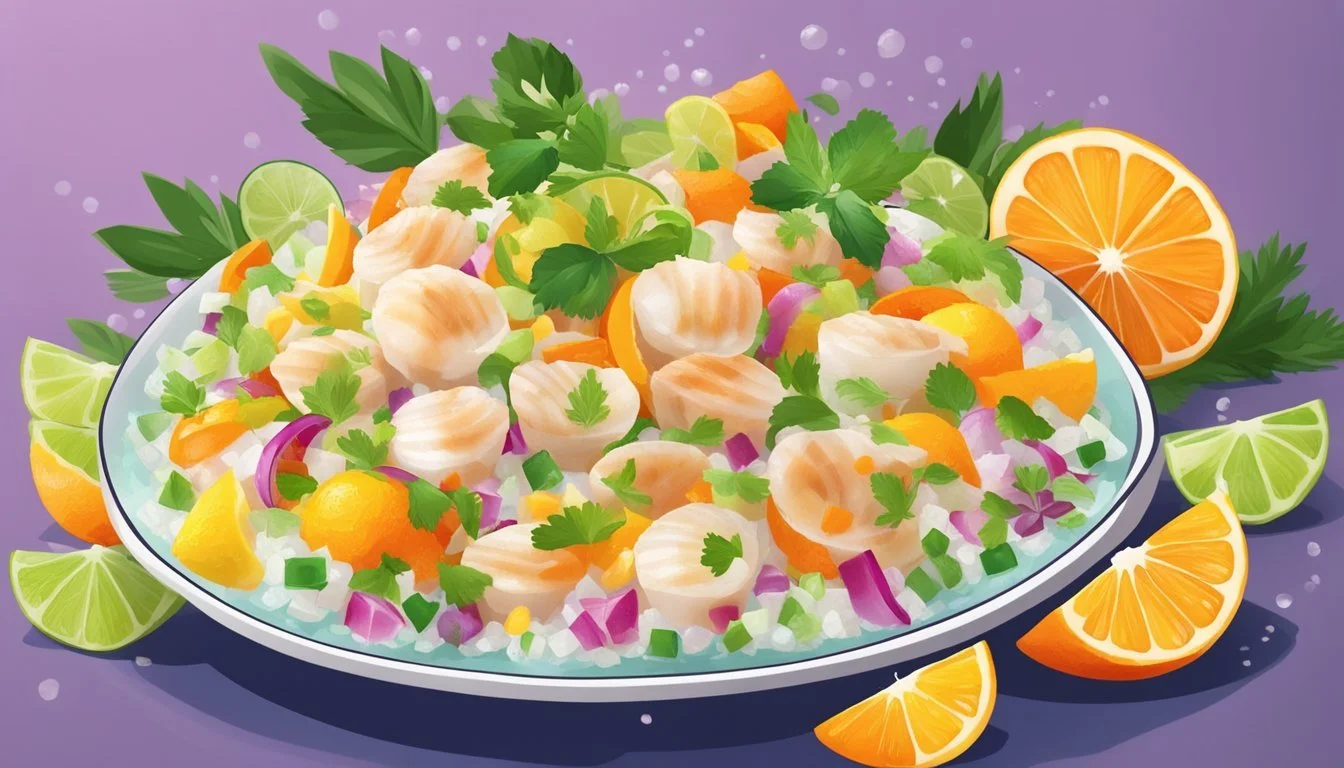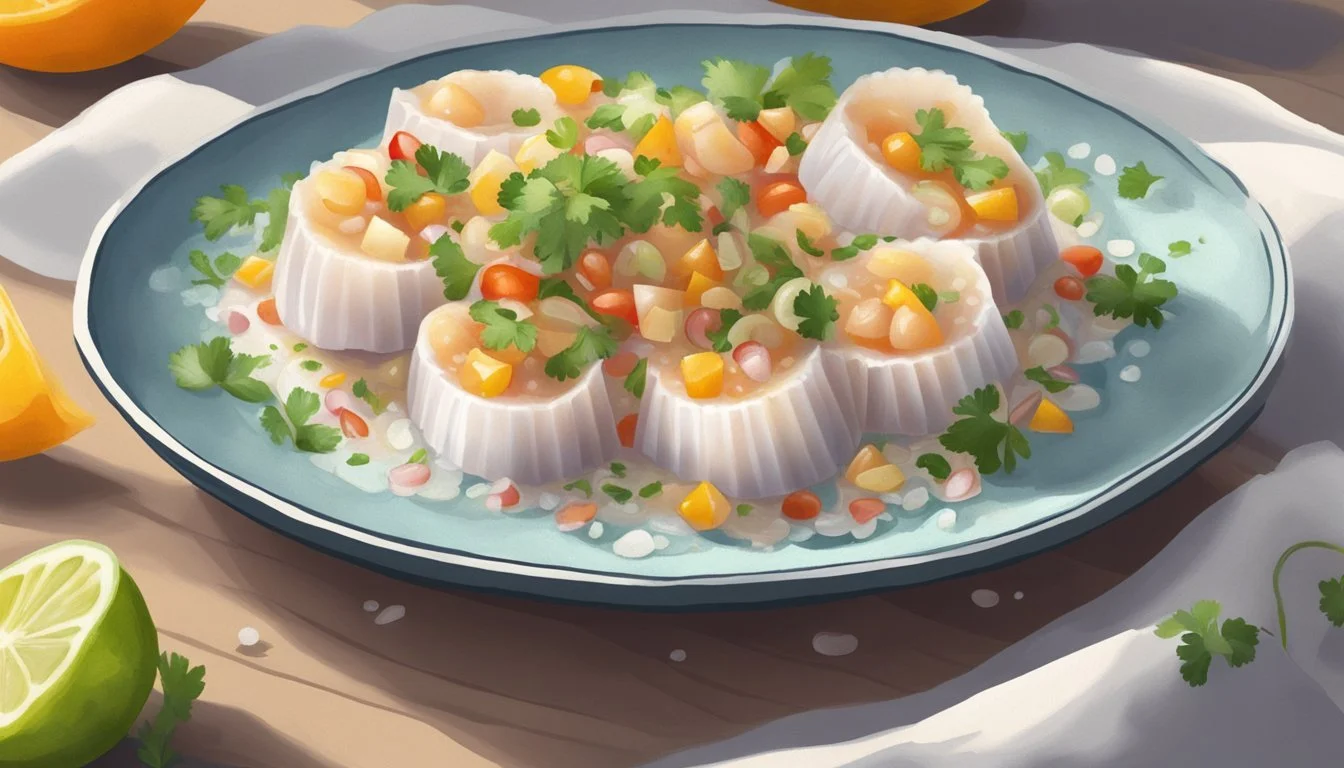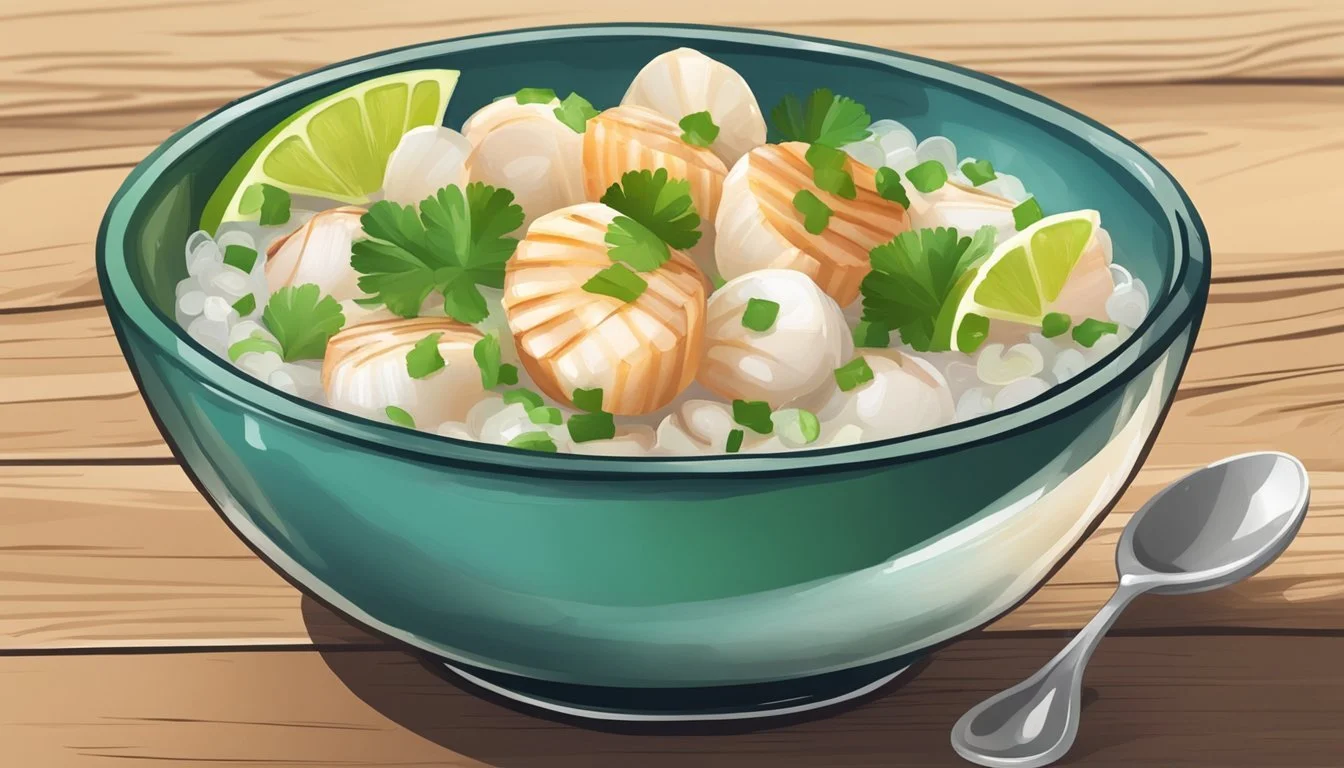How do you eat a scallop ceviche?
Mastering the Art of Enjoying this Seafood Delicacy
Scallop ceviche is a refreshing and vibrant dish commonly enjoyed as a summer appetizer. It consists of fresh scallops (What wine goes well with scallops?) that have been marinated in an acidic mixture of citrus juices, which essentially "cooks" the seafood (What wine goes well with seafood?) without heat. The result is a delicate and tangy preparation that's both light and satisfying, making it an ideal choice for warm weather dining or as a starter to a multi-course meal. The key to a perfect scallop ceviche lies in the balance of flavors and the quality of the ingredients, with the scallops themselves being the star of the show.
To eat scallop ceviche, it is typically served chilled and can be presented in a variety of ways. Some may prefer it in small bowls with a spoon to ensure they get every last bit of the flavorful marinade, while others might enjoy it atop a crisp salad or with a side of chips for added texture and crunch. The method of enjoying scallop ceviche often depends on the eater's personal preference and the specific recipe used.
When consuming this seafood delicacy, one savors the combination of the tender scallops with the accompaniment of vibrant ingredients like tomatoes, cilantro (how long does cilantro last?), onion, and peppers that are often included in the dish. This mix of fresh components adds to the complex yet balanced profile of the ceviche. Moreover, the citrus-based marinade not only imparts a bright flavor but also acts as a medium through which the scallops become safe to eat, as the acidity denatures the proteins in a similar fashion to cooking with heat.
Understanding Ceviche
Ceviche is a culinary delight that combines fresh seafood with the acid from citrus fruits to create a delectable dish. Its simplicity and versatility have earned it acclaim in kitchens around the world.
The Basic Concept of Ceviche
Ceviche, at its core, is a dish where raw fish is cured or marinated in citrus juice. Key ingredients typically include freshly caught seafood such as scallops, alongside lime juice or lemon juice which act as the cooking medium. This citric acid from the fruits causes the proteins in the seafood to become denatured, effectively cooking it without heat. The marinating process can vary in time, but the seafood must be immersed long enough to ensure it has been treated by the acidity.
Ceviche Variations
While traditional Peruvian ceviche often features a simple marinade of citrus juice and seasonings, various regions have adapted the recipe to suit local tastes. In Mexico, for example, ceviche might also include tomato juice or orange juice for a sweeter, zestier flavor profile. The type of seafood can range from white fish (What wine goes well with white fish?) to shellfish, (What wine goes well with shellfish?) and additional ingredients might include onions, chili peppers, and herbs like cilantro.
Ceviche Throughout South America
Ceviche is integral to South American culinary traditions, particularly in Peru where it's considered part of the national heritage. Peruvian ceviche is known for its incorporation of Peruvian limes, which are considered key to its distinctive taste. Beyond Peru, countries such as Ecuador, Chile, and Colombia have all cultivated their own versions of ceviche, demonstrating the dish's adaptability and the broad appeal of its fresh, tangy flavor profile.
Selecting Ingredients
The success of a scallop ceviche hinges on using high-quality, fresh ingredients, particularly when it comes to the scallops. Ensuring the freshness and the right choice of scallops and any additional seafood is crucial for the perfect ceviche.
Choosing the Right Type of Scallop
When selecting scallops for ceviche, one generally has two main options: bay scallops and sea scallops. Bay scallops are smaller, sweeter, and more tender, making them ideal for the delicate nature of ceviche. Sea scallops are larger and can be used as well, but should be cut into smaller pieces to absorb the marinade effectively.
Bay scallops: Preferred for their size and sweetness.
Sea scallops: Must be cut into smaller pieces if used.
Additional Seafood Options
While scallops are the staple of ceviche, one might consider adding other seafood for variety. Options like shrimp, sea bass, salmon, or flounder can complement the scallops. They should be fresh and prepared in bite-sized pieces to ensure even marination.
Shrimp: Cleaned and deveined, cut to match the scallop size.
Fish options (sea bass, salmon, flounder): Slice into small, uniform pieces for consistency.
Freshness and Quality
For the best ceviche, freshness is non-negotiable. Fresh scallops should have a moist sheen and a sweet, clean ocean smell. If fresh scallops are not available, frozen scallops can be an alternative, but they must be fully thawed and dry before use. Avoid scallops that have a fishy smell or are excessively dry, as these are indicators of lower quality.
Fresh scallops: Look for a moist sheen and a mild smell.
Frozen scallops: Thaw completely and ensure they're dry to touch.
When incorporating these elements, the chosen seafood should meld together in flavor and texture, elevating the scallop ceviche to an exquisite culinary experience.
Preparation Techniques
The essence of creating a perfect scallop ceviche lies in meticulous preparation. From selecting the freshest scallops to precise marination, each step is crucial for achieving the desired flavor and texture.
Preparing Scallops for Ceviche
To begin, one must ensure the scallops are fully defrosted if they are not fresh. Defrosting should be done in the refrigerator to maintain a consistent, safe temperature. Once defrosted, scallops should be cleaned thoroughly under cold running water. Careful slicing is next; for a ceviche, scallops are typically cut into thin, even rounds or small cubes, depending on the recipe. This uniformity is pivotal for even marination and to ensure each bite offers a consistent texture.
Marinating the Scallops
Marination is where the magic happens in transforming seafood recipes, particularly ceviche. Citrus marinade is the heart of ceviche. A balanced blend of acidic components like lime juice, lemon juice, and occasionally orange juice, is combined to create the marinating liquid. Scallop ceviche marination typically lasts between two and six hours; this allows the acids in the citrus to 'cook' the scallop pieces, infusing them with flavor and altering their texture. One must achieve the right marination time – not underdone to avoid overly chewy pieces, and not overdone to prevent mushiness.
Handling and Safety
While preparing scallop ceviche, one must handle the ingredients with utmost care to prevent foodborne illnesses. Only the freshest seafood should be used for making ceviche, as the acid in the marinade does not kill bacteria or parasites as effectively as heat. Consequently, purchasing seafood from reputable sources is of paramount importance. It is also crucial to keep the scallops refrigerated up until preparation and to marinate them in a chilled environment. After marinating, any unused ceviche should be discarded after a day to prevent health risks that come from consuming degraded seafood.
Complementary Ingredients
When preparing scallop ceviche, selecting the right mix of ingredients is crucial for achieving a balanced and flavorful dish. Key to this is understanding how each element complements the scallops and contributes to the overall taste profile of the ceviche.
Mix-Ins That Enhance Flavor
Citrus and Acidity: Fresh lime juice is a traditional and essential ingredient, as its acidity cooks the scallops and adds a bright flavor. For added complexity, a splash of orange juice can be mixed in.
Heat Elements: To introduce some heat into the ceviche, mincing fresh jalapeños or serrano peppers works well. One can adjust the amount based on their heat preference. Incorporating red onion provides a sharp, sweet contrast that enhances the dish's flavors.
Balancing Spice and Seasoning
Seasonings: Generous seasoning with salt and pepper is important to elevate the natural flavors of the ingredients. One can add a pinch of rating for an extra layer of taste complexity.
Counterbalance for Spiciness: For those sensitive to spice, adding cucumber or avocado can provide a cooling effect, balancing out the heat from the peppers.
Herbs and Vegetables
Herbs: Cilantro and parsley are fresh herbs that can be finely chopped and added to the ceviche, lending a herbaceous note to the dish.
Vegetable Variety: Some commonly incorporated vegetables include diced tomatoes for juiciness, sliced radishes for crunch, and sweet potatoes for a touch of sweetness. Additional options might include corn, lettuce, or mango for varied textures and flavors.
Serving Suggestions
Scallop ceviche, known for its blend of fresh flavors and light textures, offers a versatile serving experience. Presentation and accompaniments can greatly enhance the enjoyment, while a thoughtful wine pairing elevates the entire dish.
Presentation Ideas
To create a visually appealing dish, scallop ceviche should be served in a clear glass to showcase its vibrant colors and textures. Plantain chips or tortilla chips can be arranged artfully around the ceviche for an inviting display. A garnish of cilantro or a slice of lime can add a fresh touch.
Accompaniments
For a satisfying meal, scallop ceviche can be served with light sides that complement the citrusy profile. Consider offering:
Sweet potato: Boiled and sliced, adds a sweet balance.
Pineapple: Chopped, for a tropical twist.
The dish can also be presented in a variety of formats, such as atop a green salad, inside a poke bowl with quinoa or rice, or even with a side of light corn chips for added crunch.
Wine Pairing
A glass of wine that complements the delicate flavors of scallop ceviche is key. Opt for a light, citrusy white wine:
Sauvignon Blanc: Crisp and refreshing, pairing well with the lime juice.
Pinot Grigio: Light-bodied, enhancing the citrus without overpowering.
Each wine choice aims to match the ceviche's freshness and zest, ensuring a harmonious dining experience.
Nutritional Information
Scallop ceviche is a dish known for its freshness and nutritional benefits. A typical serving size of scallop ceviche contains approximately 200-250 calories, making it a light yet fulfilling choice for health-conscious individuals.
The fat content in scallop ceviche is relatively low. On average, a serving consists of about 6-7 grams of total fat, of which only around 1 gram is saturated. The presence of unsaturated fats, such as polyunsaturated and monounsaturated fats, is notable for their positive effects on heart health.
One central aspect of scallop ceviche’s nutritional profile is its cholesterol content. A serving has about 35-46 milligrams of cholesterol, constituting a moderate amount for a seafood dish.
In terms of vitamins and minerals:
Vitamin C: This antioxidant is present in the fresh citrus juices commonly used to marinate the scallops, although the exact amount will depend on the quantity of citrus used.
Calcium: While not a primary source of calcium, scallop ceviche contains small amounts from the scallops themselves.
Iron: Seafood, including scallops, can provide a source of iron, an essential mineral for blood production.
Potassium: Scallops are a natural source of potassium, which is required for normal cell function.
Here's a breakdown in list format:
Calories: 200-250
Total Fat: 6-7g
Saturated Fat: ~1g
Trans Fat: 0g
Polyunsaturated Fat: ~1.1g
Monounsaturated Fat: ~3.6g
Cholesterol: 35-46mg
Sodium: Around 760mg
Vitamin C: Depends on citrus quantity
Calcium: Available in small amounts
Iron: Present from the seafood component
Potassium: Naturally occurring
These figures can vary depending on specific recipe ingredients and portion sizes. Consumers concerned about specific dietary needs should adjust the recipe accordingly or consult a nutritionist to adapt this delightful seafood dish to their dietary plans.
Health and Safety Considerations
When preparing scallop ceviche, food safety takes precedence to ensure the dish is both delightful and safe to consume. It is vital to manage raw fish and fresh seafood with care to prevent foodborne illnesses.
Proper Handling of Ingredients
Selection of Seafood: Scallops must be incredibly fresh or properly frozen to ensure they are safe for ceviche. Freshness reduces the risk of bacteria and parasites that can thrive in raw fish.
Temperature Control: Maintaining scallops at 41°F or below prevents bacterial growth. Always keep scallops refrigerated before use and acidify promptly after preparation.
Acidification: Lemon or lime juice is applied not to cook, but to acidify the scallops. Although it changes the texture, it does not eliminate all microorganisms. Hence, the quality of the starting product is critical.
Keep in Mind Description Cross-Contamination Use separate cutting boards and knives for seafood and other ingredients. Storage Once prepared, store ceviche at the right temperature and consume or discard within seven days. Cleanliness Hands and surfaces must be kept clean to minimize contamination.
Dealing with Food Allergies
Allergen Information: Clearly identify scallops as shellfish, a common allergen, to alert those with allergies.
Preventing Exposure: If preparing other dishes, ensure there is no cross-contamination by using separate utensils and preparation areas for the ceviche.
Food allergies can be severe, and appropriate measures should always be taken to inform and protect consumers.
Cookware and Utensils
When preparing scallop ceviche, the choice of materials for marination and the right preparation tools are crucial for optimal taste and safe food handling.
Best Materials for Marinating
For marinating scallop ceviche, glass and ceramic bowls are recommended. They are non-reactive materials, which means they won't impart any metallic taste to the delicate seafood or affect the acidity of the lime juice. Additionally, these materials don't react with the citric acid, ensuring that the scallops maintain their fresh flavor.
Glass: Ideal for observing the marinade progress and ensuring even coating of the scallops.
Ceramic: Keeps a consistent temperature, which helps in the even "cooking" process of the scallops in the lime juice.
It is advised to avoid aluminum and copper bowls, as the acid in the marinade can react with metal, potentially leaving an undesirable taste and discoloring the seafood.
Tools for Preparation and Serving
Sharp knives and chopping boards are essential tools in preparing the ingredients for scallop ceviche. A sharp knife ensures precise slicing of scallops and dicing of complementary ingredients, while separate chopping boards help avoid cross-contamination.
Knife: A sharp chef's knife or a serrated knife for cleanly cutting scallops and other ingredients.
Chopping Board: At least one board for seafood and another for vegetables to maintain proper hygiene.
For serving, one might consider the following:
Spoon: A slotted spoon to serve the ceviche, allowing excess marinade to drain.
Bowls: Small serving bowls or glasses that complement the elegant appearance of the ceviche.
Platter: A large platter for buffet-style serving, if preferred.
In third person perspective, an individual should ensure the maintenance of non-reactive cookware for marination and sharp, clean utensils for preparation and serving to enhance the dining experience.
Recipe and Instructions
Scallop ceviche, a seafood dish typically made with fresh raw scallops cured in citrus juices, is a delicacy that combines vibrant flavors and a delicate texture. The key to an outstanding ceviche lies in the quality of the scallops and the balance of the marinade, which includes both lime juice for curing and a blend of citrus for flavor.
Step-by-Step Guide
Select Fresh Scallops: For the best texture and flavor, use fresh bay scallops. They are the ideal size for ceviche and have the perfect tenderness.
Prepare the Marinade: Combine lime juice with orange juice for a balanced citrus profile that complements the sweetness of the scallops, without overpowering them.
Cure the Scallops: Place the scallops in a non-reactive bowl and pour the citrus marinade over them. Ensure all the scallops are completely covered by the juice.
Marination Time: Cover the bowl and refrigerate the scallops for about 30 minutes to an hour, depending on their size. The citrus acid will "cook" the scallops.
Final Touches: Once the scallops turn opaque, indicating they are cured, add diced green tomatoes, minced shallots, and a finely chopped jalapeño for heat.
Tips and Tricks for Best Results
Acid Balance: Be mindful of the lime juice's acidity; it's essential for both flavor and curing the scallops. Test the citrus balance before adding the scallops—the marinade should be tangy but not overly sour.
Texture Review: The texture of the scallop ceviche should be firm yet tender. Overmarinating can lead to chewy and rubbery scallops. Regularly review the texture during the curing process.
Serving & Presentation: Serve the scallop ceviche cold. It can be enjoyed in small bowls or as a dip with chips. Decorate with fresh herbs like cilantro for a refreshing aroma and presentation flair.
Frequently Asked Questions
What seafood can I use in ceviche aside from scallops? One can utilize various types of seafood for ceviche, including shrimp and different kinds of fish. The choice of seafood heavily depends on personal preferences and the desired texture.
How long should I marinate scallop ceviche in the fridge? Ceviche should be marinated in the fridge for at least 30 minutes. For optimal flavor, some recommend marinating for 1 to 2 hours if the scallops are fresh. Always ensure that the seafood is submerged in the acidic juice to "cook" properly.
Is lemon suitable for making ceviche or should I stick to limes? Both lemon and limes are suitable for ceviche as they provide the necessary acidity. Limes are traditionally used and offer a distinct tanginess, but lemons can be a suitable substitute or addition.
Should I include red chili in my scallop ceviche? Inclusion of red chili depends on one's preference for heat. Chilies can be finely chopped and added for a spicy kick. The heat level can be adjusted according to taste.
Are the scallops in ceviche actually cooked? Scallops in ceviche are not cooked in the traditional sense with heat. Instead, the acid from citrus juices denatures the proteins in the seafood, which gives it a cooked appearance and texture.
What role does olive oil play in preparing a scallop ceviche? Olive oil is not essential, but a drizzle can add richness and balance to the acidity of the ceviche. It can be used as a garnish before serving.








